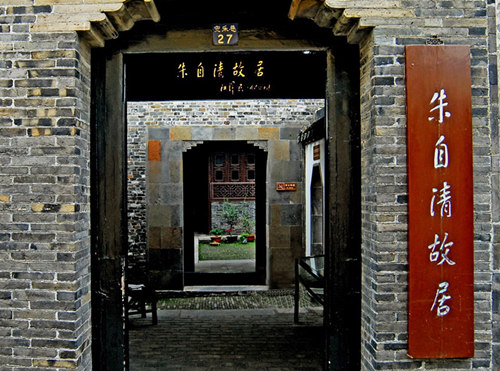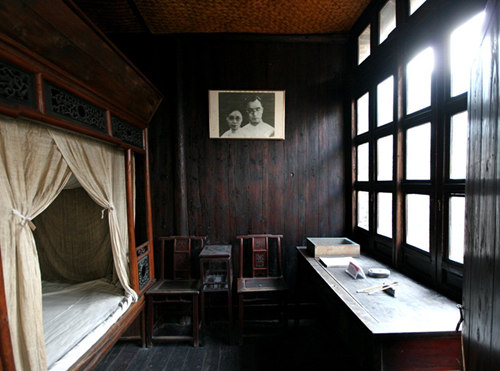
The former residence of Zhu Ziqing was built in the Qing Dynasty (1644-1911) in the form of a Sanheyuan (a courtyard enclosed in three directions) -- a typical residential style in Yangzhou. The entrance, main halls, courtyard and wing rooms were constructed of thin bricks and tiles, and the window lattices, tables, long desks, cabinets and large beds painted with varnish vividly reproduce Zhu Ziqing’s domestic life.
A summer scene in the ancient city has been carved out by the beautiful lotus pond, and the receding view of the hometown is reflected in Peixian’s literary grace (Peixian is a name of Zhu Ziqing that was called after he reached adulthood). Some of Zhu Ziqing’s furniture and manuscripts are displayed at the residence.

Attractions:
1. Reception room
Opposite the front door is a red board inscribed with “The Former Residence of Zhu Ziqing” in golden characters by former president Jiang Zemin. Many visitors stop and take photos of the inscription. Walking past the main hall and turning right, a hexagonal door, which leads to the reception room, will come into view. The reception room is bright and clean, and the decoration is simple and unadorned. The bed in the bedroom faces the south, behind it is a window under which stands a desk. On the desk are the four treasures of the study (writing brush, ink stick, ink slab and paper).Of these, the blue-pattern writing brush which was used by Zhu Ziqing for a long time is the most precious; it was gifted by Zhu Ziqing’s son Zhu Qiaosen in 1992. On the desk is a bamboo brush pot which was abandoned in 1946 when the Zhu family moved. The landlord kept it for 60 years and donated it on Zhu’s 110th birthday in 2008. The brush pot is around 100 years old.
Hung on the wall is awedding photo of Zhu Ziqing and Chen Zhuyin. Outside the bedroom is a small reception room whose walls are hung with Zhu Ziqing’s portraits. Among them is an oil painting from the famous Beijing oil painter Li Zongjin. Abronze statue, which was sent by Tsinghua University in celebration of the opening of the residence in 1992, stands facing the south. Outside the house is a small courtyard, under the south wall of which is a flower bed. The osmanthus flowers in the bed give forth fragrance all year round, bringing comfort and joy.
2. Lower main hall
At the side of the east door is a set of three rooms. The two rooms at the ends are symmetric to each other. The three rooms open to the courtyard. Flying bats are carved on the six doors, and the doors at the front and rear sections are in the same style. The east room was resided in by Zhu Xiaowu -- the fifth daughter of Zhu Ziqing; the west room was originally connected to the west room of the upper main hall, and was resided in by Zhu Runsheng -- the second son of Zhu Ziqing, when he attended high school.
3. Upper main hall
The upper main hall is opposite to the lower main hall, the west room of which was the bedroom of the concubine of Zhu Ziqing’s father. The most noteworthy article in the bedroom is the photo hung on the west wall, it was taken in a photo studio when Zhu Xiaopo (Zhu Ziqing’s father) visited the Slender West Lake with his grandchildren: Zhu Runsheng, Zhu Tixian and Zhu Xiaowu. Outside the west room standing next to its west wall is a chinaberry tree, the tree is more than two zhang (one zhang equals 3.33 meters) higher than the room, and its canopy resembles a gigantic umbrella. Winding around the tree are two rare wistaria variants which grow white flowers. In spring, the strings of white wistaria flowers and the vivid chinaberry leaves complement each other, creating layers of pleasant colors, full of charm. When the wistaria blossoms wither, dense violet flowers bloom on the chinaberry tree, producingstronga fragrance and drizzle from the tree like purple rain. Visitors are always amazed by the fragrance, noting that it resembles the scent of sandalwood.
4, Lead-in hall.
The lead-in hall faces the east, centering on the wall painting on the light box which is inscribed with “The nobility and integrity of Zhu Ziqing influence every generation” by Jiang Zemin. The lotus painting sets off the full-size statue of Zhu Ziqing, which was created by the Yangzhou sculptor Chang Zaisheng by using high polymer stone-like materials.
5, Exhibition hall.
The exhibition hall had been the main hall for the landlord’s family. Now, the indoor exhibition is presented by means of wallboards and flat shelves. The display of the wallboards is in three threads: the first one is around the topic “I am from Yangzhou”, showing Zhu Ziqing’s domestic and marital life, as well as his growing up period. The second one focuses on the transformation of Zhu Ziqing from a philosophy student in the Peking University to a superstar in the Chinese literary world. The third one reveals the transformation of Zhu Ziqing from an honest and clean person to a democratic fighter.
Address: No 27 Anle Lane,Mid Wenchang Road,Yangzhou
Tickets: 10 yuan ($1.54)
Opening time:
Summer: 8:30 am-5:30 pm;
Winter: 8:15 am-5:00 pm
Transportation: bus No 18, 25, 26, 32 and 88; Shuttle buses; Sightseeing buses (Mar - Nov)
Tel: +86-514-8733-1925